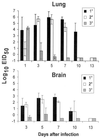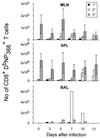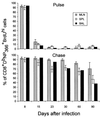Profound protection against respiratory challenge with a lethal H7N7 influenza A virus by increasing the magnitude of CD8(+) T-cell memory
- PMID: 11090168
- PMCID: PMC112451
- DOI: 10.1128/jvi.74.24.11690-11696.2000
Profound protection against respiratory challenge with a lethal H7N7 influenza A virus by increasing the magnitude of CD8(+) T-cell memory
Abstract
The recall of CD8(+) T-cell memory established by infecting H-2(b) mice with an H1N1 influenza A virus provided a measure of protection against an extremely virulent H7N7 virus. The numbers of CD8(+) effector and memory T cells specific for the shared, immunodominant D(b)NP(366) epitope were greatly increased subsequent to the H7N7 challenge, and though lung titers remained as high as those in naive controls for 5 days or more, the virus was cleared more rapidly. Expanding the CD8(+) memory T-cell pool (<0.5 to >10%) by sequential priming with two different influenza A viruses (H3N2-->H1N1) gave much better protection. Though the H7N7 virus initially grew to equivalent titers in the lungs of naive and double-primed mice, the replicative phase was substantially controlled within 3 days. This tertiary H7N7 challenge caused little increase in the magnitude of the CD8(+) D(b)NP(366)(+) T-cell pool, and only a portion of the memory population in the lymphoid tissue could be shown to proliferate. The great majority of the CD8(+) D(b)NP(366)(+) set that localized to the infected respiratory tract had, however, cycled at least once, though recent cell division was shown not to be a prerequisite for T-cell extravasation. The selective induction of CD8(+) T-cell memory can thus greatly limit the damage caused by a virulent influenza A virus, with the extent of protection being directly related to the number of available responders. Furthermore, a large pool of CD8(+) memory T cells may be only partially utilized to deal with a potentially lethal influenza infection.
Figures






References
-
- Allan W, Tabi Z, Cleary A, Doherty P C. Cellular events in the lymph node and lung of mice with influenza. Consequences of depleting CD4+ T cells. J Immunol. 1990;144:3980–3986. - PubMed
-
- Andrew M E, Coupar B E. Efficacy of influenza haemagglutinin and nucleoprotein as protective antigens against influenza virus infection in mice. Scand J Immunol. 1988;28:81–85. - PubMed
-
- Banchereau J. Dendritic cells: therapeutic potentials. Transfus Sci. 1997;18:313–326. - PubMed
-
- Bender B S, Small P A., Jr Heterotypic immune mice lose protection against influenza virus infection with senescence. J Infect Dis. 1993;168:873–880. - PubMed
Publication types
MeSH terms
Substances
Grants and funding
LinkOut - more resources
Full Text Sources
Other Literature Sources
Medical
Research Materials
Miscellaneous

